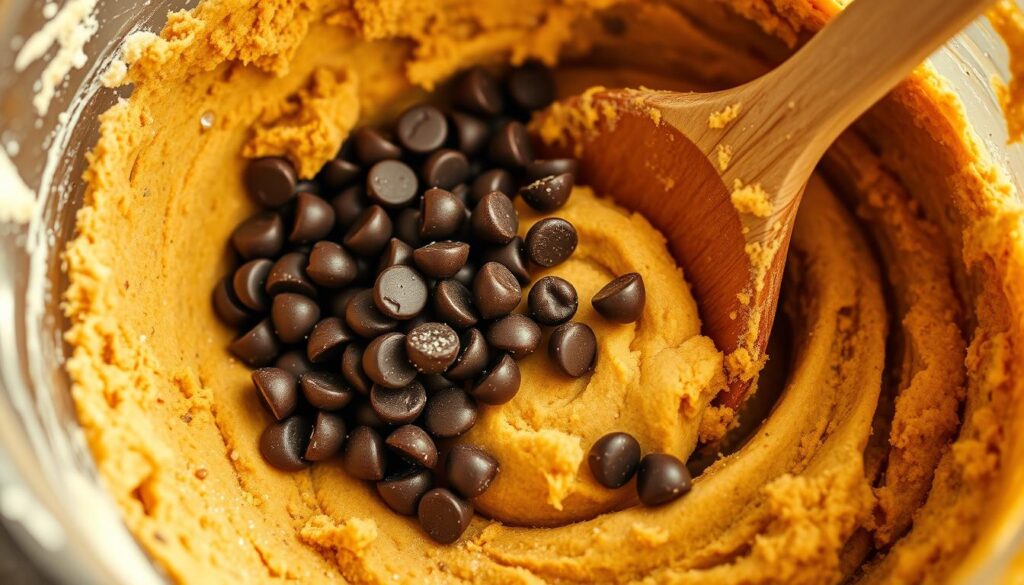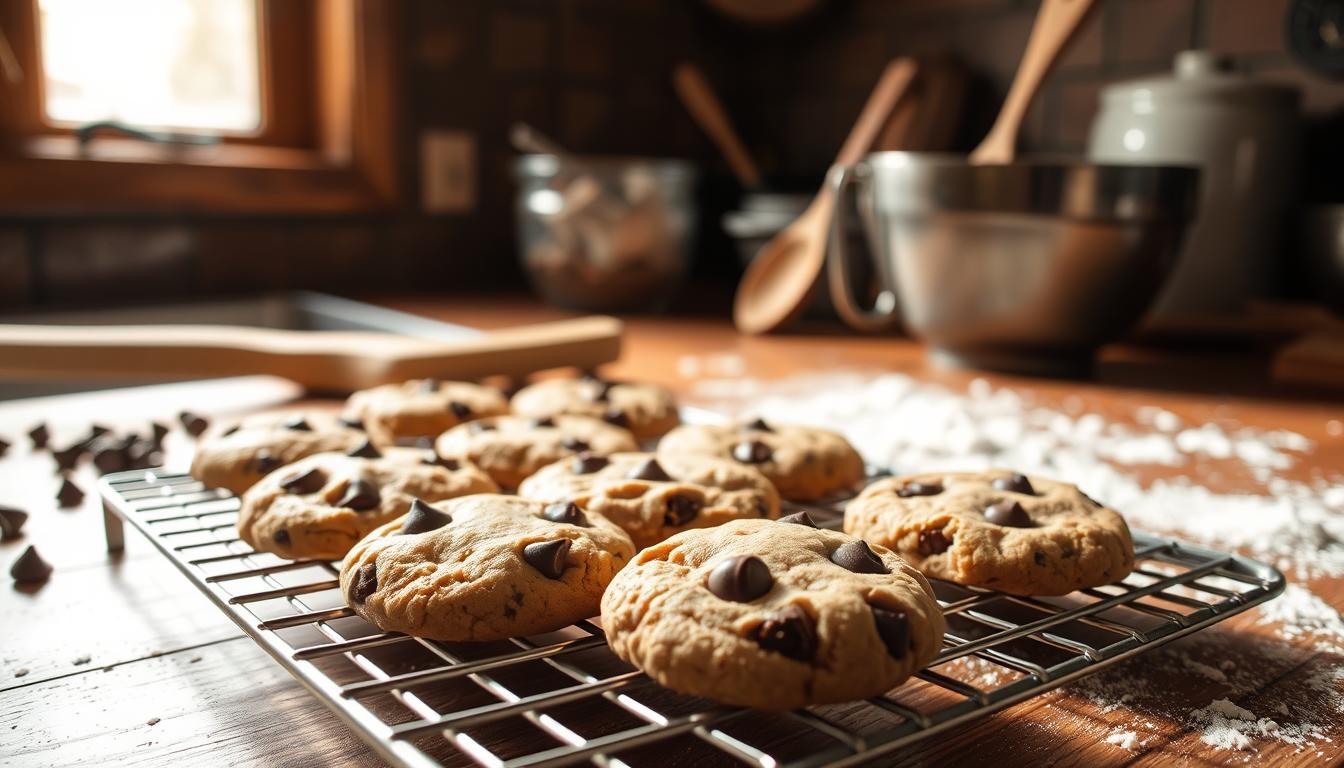The smell of fresh cookies is special to me. The Nestle Toll House Chocolate Chip Cookie recipe is a timeless favorite. It brings back memories of cozy kitchens and family moments. But, did you know this recipe has changed over the years? Small tweaks can make a big difference in the cookie’s texture.
Table of Contents
Understanding the History Behind Toll House Cookies
The Toll House Cookie recipe started in the 1930s. In 1938, Ruth Graves Wakefield, owner of the Toll House Inn in Whitman, Massachusetts, made the first chocolate chip cookie. This happy accident led to the creation of the famous Toll House chocolate chip cookie. It has since become a favorite in America.
The Evolution of the Original Recipe
The original recipe had flour, sugar, butter, chocolate chips, eggs, vanilla, baking soda, and salt. Over time, the recipe has changed a bit. These changes reflect new tastes and what’s available in the market.
Why the Classic Recipe Changed Over Time
In the 1970s, the Toll House cookie recipe got a few tweaks. It added water and used half butter and half shortening. The baking temperature also went up. These changes made the cookies crisper on the outside and chewier inside, fitting the taste of the time.
The 1970s Version Difference
The 1970s recipe was a big change from the original. It included water and a different mix of fats. This made the cookie’s texture stand out, appealing to people’s changing tastes back then. The recipe’s evolution shows how this beloved treat has grown and adapted.
“The chocolate chip cookie was an accident. I had no idea it would be so popular.”
– Ruth Graves Wakefield, inventor of the Toll House cookie
Essential Ingredients for Perfect Nestle Chocolate Chip Cookies
To make the famous Nestle Toll House chocolate chip cookies, you need a few key ingredients. These include all-purpose flour, baking soda, salt, unsalted butter, and sugars. You also need vanilla extract, eggs, and semi-sweet chocolate chips. Adding chopped nuts can make the cookies even better.
It’s important to measure the ingredients right, especially the flour. The Nestle Toll House recipe suggests adding 1-2 extra tablespoons of flour if you don’t use nuts. This helps get the cookie texture just right.
| Ingredient | Purpose |
|---|---|
| All-Purpose Flour | Provides the base structure and stability to the cookies |
| Baking Soda | Helps the cookies rise and spread, resulting in a soft and chewy texture |
| Salt | Enhances the overall flavor profile and balances the sweetness |
| Unsalted Butter | Contributes richness, flavor, and a tender texture to the cookies |
| Granulated Sugar & Brown Sugar | Sweetens the dough and adds moisture, chewiness, and caramelization |
| Vanilla Extract | Enhances the overall flavor profile with its warm and aromatic notes |
| Eggs | Bind the ingredients together and add structure to the dough |
| Semi-Sweet Chocolate Chips | Provide sweet pockets of chocolate flavor, with substitutions available |
| Chopped Nuts (Optional) | Can add texture and a nutty flavor to the cookies |
By carefully measuring and mixing these cookie ingredients, you can make the perfect Nestle Toll House morsels. These are the baking essentials every home kitchen needs.
The Secret Role of Water in Cookie Texture
Water is often overlooked when baking Nestle Chocolate Chip Cookies. Yet, it plays a big role in the texture and spread of your cookies. Knowing how water affects the dough can help you get the perfect texture.
How Water Affects Cookie Spread
The water in your dough affects how much your cookies spread. More water makes the dough runnier, leading to crisper edges. Less water results in thicker, chewier cookies.
Water-to-Flour Ratio Guidelines
Adjusting the water-to-flour ratio can change your cookie’s texture. For crisp cookies, add 1/4 teaspoon of water per cup of flour. For wafer-like cookies, use up to 1 teaspoon. Remember, other ingredients like eggs and butter also add moisture.
Steam’s Impact on Cookie Rise
Water in the dough also affects how cookies rise. As they bake, the water turns to steam. This steam helps cookies puff up, giving them a light, airy texture.
Understanding water’s role in cookie texture lets you experiment with ratios. Whether you want crispy edges, a chewy center, or both, controlling dough moisture is key. This way, you can make irresistible Nestle Chocolate Chip Cookies every time.
Mastering the Nestle Chocolate Chip Cookie Recipe
Making the perfect Nestle Toll House chocolate chip cookies is an art. It needs precision and attention to detail. By using a few key baking techniques, you can make your cookie recipe mastery shine. This way, you’ll get irresistible chocolate chip cookies every time.
Start by heating your oven to 375°F (190°C). In another bowl, mix the dry ingredients – flour, baking soda, and a pinch of salt. Keep this aside while you work on the wet ingredients.
In a big mixing bowl, mix the softened butter, granulated sugar, and brown sugar until it’s light and fluffy. Add the eggs one at a time, then the vanilla extract. Slowly add the dry ingredients to the wet mixture, but don’t overmix.
- Add the semi-sweet chocolate chips, and if you like, chopped walnuts or pecans.
- Use a cookie scoop or tablespoon to make even-sized balls. Place them on a baking sheet lined with parchment paper or a silicone mat.
- Bake for 9 to 11 minutes, until the edges are golden and the centers are still a bit soft.
- Let the cookies cool on the baking sheet for 15 to 20 minutes. Then, move them to a wire rack to cool completely.
By following these steps, you’ll learn to make perfect Nestle Toll House chocolate chip cookies. They’ll be crisp on the edges, chewy in the center, and full of chocolate flavor. Share them with family and friends, or give them as thoughtful gifts to show off your cookie recipe mastery.
| Nutrition Facts | Per Cookie |
|---|---|
| Total Calories | 160-170 kcal |
| Total Fat | 8g |
| Saturated Fat | 5g |
| Cholesterol | 20mg |
| Sodium | 85mg |
| Total Carbohydrates | 22g |
| Dietary Fiber | 1g |
| Sugars | 12g |
| Protein | 2g |

“Baking is like washing clothes – the more you do it, the better you get.” – Anonymous
The Science of Flour Measurement
Getting the perfect Nestle chocolate chip cookies starts with flour measurement. The right amount of flour changes the cookie’s texture and feel. Knowing how to measure flour accurately is key to great results.
Different Measuring Techniques
There are three ways to measure flour: the 120 grams per cup method, the aerate-spoon-level method, and the scoop-and-level method. Each method can change the flour amount by up to 1/2 cup. This difference can greatly affect your cookies’ texture.
Weight vs. Volume Measurements
Nestle says 281 grams is equal to 2 1/4 cups of flour. But using 312 grams makes cookies look more like the website pictures. Weighing ingredients instead of using volume measurements leads to better baking precision.
Impact on Cookie Texture
The flour amount greatly affects the cookie consistency. More flour makes cookies denser and chewier. Less flour makes them lighter and more delicate. By understanding flour measurement, you can adjust your recipe for the perfect flour measurement and cookie consistency.
“Precise flour measurement is the key to achieving the perfect Nestle chocolate chip cookie texture.”
Temperature and Mixing Techniques
For perfect Nestle Chocolate Chip Cookies, temperature and mixing matter a lot. Start with softened butter and eggs at room temperature. Cream the butter and sugars for a minute before adding eggs.
Slowly add the dry ingredients like flour, baking soda, and salt. This prevents over-mixing. Then, gently fold in the chocolate chips by hand. This keeps the dough right and the cookies soft.
For chewier cookies, chill the dough for 30 minutes. This makes the dough firmer, leading to better texture. Bake at 375°F for 9 to 11 minutes. The edges should be golden, and the centers soft.
| Ingredient | Quantity |
|---|---|
| Unsalted Butter | 1 cup |
| Brown Sugar | 3/4 cup |
| Granulated Sugar | 3/4 cup |
| Large Eggs | 2 |
| Vanilla Extract | 1 teaspoon |
| All-Purpose Flour | 2 1/4 cups |
| Baking Soda | 1 teaspoon |
| Salt | 1 teaspoon |
| Nestle Toll House Semi-Sweet Chocolate Chips | 2 cups |
| Chopped Nuts (optional) | 1 cup |
Right mixing and temperature control are key. They ensure ingredients mix evenly. This avoids tough cookies and gives you soft, chewy, delicious treats.

Butter vs Shortening: Making the Right Choice
Choosing between butter and shortening is key for perfect Nestle Chocolate Chip Cookies. Butter adds a rich flavor but can make cookies spread out. Shortening, on the other hand, makes cookies soft and keeps their shape.
Benefits of Using Combined Fats
Some bakers mix butter and shortening for the best of both. This mix creates a cookie that’s both thick and soft. By adjusting the butter to shortening ratio, you can get cookies with crisp edges or a soft center.
Texture Differences Between Options
- Butter: Provides unbeatable flavor but can lead to flatter, more spread-out cookies.
- Shortening: Creates a softer, more tender texture and helps cookies hold their shape.
- Butter and Shortening Blend: Yields a thick, chunky cookie with a soft, chewy interior.
The choice between butter, shortening, or a mix depends on what you like. Trying different fat ratios can help you find the perfect cookie texture.
Storage and Freezing Methods
Keeping your homemade Nestle Chocolate Chip Cookies fresh is key. Let them cool down completely before storing them in a sealed container or bag. This way, they stay soft and chewy for 4-5 days.
Freezing is a good choice for longer storage. Baked cookies can stay frozen for 3-4 months in a sealed container or bag. Make sure they’re cool before freezing to keep their taste and texture. You can also freeze the dough for up to 3 months.
Freeze the dough into balls, then freeze them on a baking sheet. Once solid, move them to a sealed bag for later use. When you’re ready to bake, thaw the dough at room temperature for 30 minutes. Then, bake as you normally would.
FAQ
What are the key ingredients for making Nestle Toll House Cookies?
How has the original Toll House Cookie recipe evolved over time?
What is the role of water in cookie texture?
How does flour measurement impact cookie texture?
What is the difference between using butter and shortening in cookies?
How can you properly store and freeze Nestle Toll House Cookies?
Source Links
- Nestle Toll House Chocolate Chip Cookies – https://saltandbaker.com/nestle-toll-house-chocolate-chip-cookies/
- Nestle Toll House Cookie Recipe – https://www.iheartnaptime.net/nestle-toll-house-cookie-recipe/
- Nestle Toll House Cookie Recipe In 8 Steps: Your Ultimate Guide to Perfect Chocolate Chip Cookies – https://recipespulse.com/nestle-toll-house-cookie-recipe/
- Chocolate chip cookie – https://en.wikipedia.org/wiki/Chocolate_chip_cookie
- The Fascinating History of Chocolate Chip Cookies – https://taylorchip.com/blogs/news/history-chocolate-chip-cookies?srsltid=AfmBOoooJpjAnFTgxK8JaJqMAq_a-qkwErQNV4AEih-IKm1XEbbKHnOj
- I spent months researching the chocolate chip cookie. Here’s everything I learned. – https://www.masslive.com/food/2024/08/i-spent-months-researching-the-chocolate-chip-cookie-heres-everything-i-learned.html
- Cooking For Engineers – https://www.cookingforengineers.com/recipe/185/Nestle-Toll-House-Chocolate-Chip-Cookies/10
- Nestle Toll House Chocolate Chip Cookies – https://thefirstyearblog.com/toll-house-cookie-recipe/
- Ultimate Chocolate Chip Cookies: Crispy, Chewy, and Never Flat – https://www.onceuponachef.com/recipes/the-best-chocolate-chip-cookies.html
- This Retro Toll House Cookie Recipe Calls for a Secret Ingredient – https://www.simplyrecipes.com/tollhouse-cookie-secret-ingredient-8651507
- The Best Chewy Sourdough Chocolate Chip Cookies – https://simplicityandastarter.com/the-best-chewy-sourdough-chocolate-chip-cookies/
- Nestle Chocolate Chip Cookies– Easy Homemade Recipe – https://www.lucidrecipes.com/nestle-chocolate-chip-cookies/
- The BEST Chewy Chocolate Chip Cookies – https://asassyspoon.com/chocolate-chip-cookies/
- CHEWY Small Batch Chocolate Chip Cookies – Scientifically Sweet – https://scientificallysweet.com/small-batch-chewy-chocolate-chip-cookies/
- Best Chocolate Chip Cookie Bake Off – The Pancake Princess – https://www.thepancakeprincess.com/best-chocolate-chip-cookie-bake-off/
- Jacques Torres Chocolate Chip Cookies – https://www.teaching-tiny-tots.com/jacques-torres-chocolate-chip-cookies.html
- Toll House Cookies Recipe – https://www.sugarandsoul.co/toll-house-cookie-recipe/
- The BEST Chocolate Chip Cookies! | Gimme Some Oven – https://www.gimmesomeoven.com/chocolate-chip-cookies/
- Homemade Chocolate Chip Cookies – https://www.bettycrocker.com/recipes/homemade-chocolate-chip-cookies/77c14e03-d8b0-4844-846d-f19304f61c57


